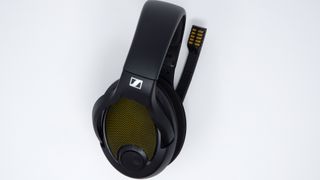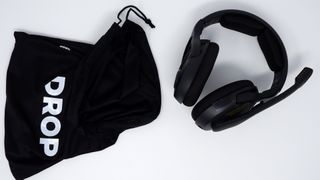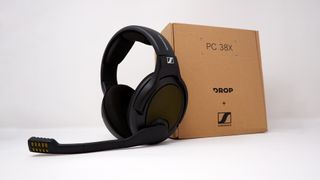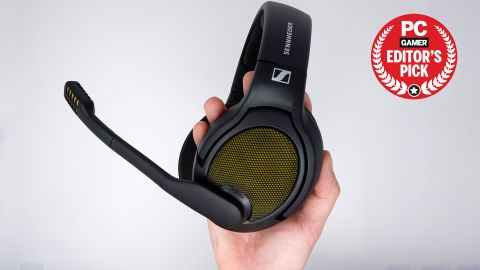Our Verdict
The Drop + Sennheiser PC38X is one of the best gaming headsets I've used in terms of raw audio quality. Paired with a straightforward design, it's a real winner for gamers that don't mind a wire.
For
- Stunning audio quality with excellent depth across the range
- Easy to use and mute microphone
- Smart and simple construction
- Lightweight
- Comfortable to wear over long periods
Against
- Microphone doesn't deal well with plosives
- On the pricey side for a wired pair
- Returns are a hassle if you're not in the US
PC Gamer's got your back
Drop (previously Massdrop) has been teaming up with popular headset companies for years now, with a view to producing cheap alternatives to fan favourites. The PC38X is one such headset: a collaboration with Sennheiser, and later Epos, to produce a more affordable open-back that the excellent audio quality these companies are known for. But when you're stripping back a headset to basics are you still able to get the best out of it?
Yes, you absolutely can.
The PC38X sounds seriously gorgeous. While there's a lot less to it than some other gaming cans on the market, especially versus its competition at $139, it nails the essentials just so.
Drop is the primary supplier of the headphones, and is a US-based company. Though it does also offer international shipping at $15. That could mean these take a little longer to reach you than a local supplier if you're outside the US, and does make returns a bit of a hassle—US customers get free returns while international customers will need to cover that cost themselves. Let's hope it doesn't come to that.
But when I talk about the PC38X going back to basics, I really mean it. The headset arrives in a rather unassuming brown box, with little to no pizzazz about it. Inside you'll find more of the same: a black sack containing the headphones and a piece of cardboard to keep the cables at bay. But who cares about a fancy box, right? I'd rather no expense was spared on the headset itself rather than some box I'll leave to gather dust in a cupboard for a couple of years.
It's the headset that matters, and the PC38X makes a great first impression. It's a sleek black design with a few splashes of yellow dotted around—located between the driver and the mesh on the outer earcup, inside the microphone, and along the length of the included cables. Yes, it's primarily plastic, but so are some of Sennheiser's best headphones, and it feels durable nonetheless. The matt black finish rounds off a generally sleek and simple design, and there's a single dial for volume control within easy reach on the right ear cup.

Type: Dynamic, open-back
Frequency response: 10–30,000Hz
Drivers: 42mm
Nominal impedance: 28Ω
Connectivity: 3.5mm jack (2.5m 2 x 3.5 mm cable, 1.5m 1 x 3.5 mm cable)
Weight: 253g
Price: $139 (worldwide shipping available for $15)
So about this Epos version of the same headset. It comes in a tamer all-black design but is materially the same as the Sennheiser branded version. Sennheiser's gaming division was spun off into Epos some time ago, and since then it's been gradually rebranding each headset with the Epos badge, including these Drop collabs. Both pairs are the same price, so it's just down to personal preference which you go for.
Back to the headphones at hand and there are two cables included in the package. One is a longer 2.5 metre cable with 2 x 3.5mm connectors; one microphone and one headphone input. Then there's what's referred to as the 'console cable', a 1.5 metre cable that combines both inputs into a single 3.5mm. I get that this is supposed to be to plug into the base of your PlayStation controller, and it's sure handy at that, but for your average PC user it also makes for a handy short cable to run from the front panel connector on your case. A short run keeps it from bunching up near the base of your chair and getting mowed over and destroyed, which I've never ever done, I assure you.

Both included cables utilise Sennheiser's compact audio jack to connect to the headset, meaning you'd need to pick up another like-for-like cable if you want to replace it down the line. The included two are braided, so should last a while. Though the flipside of braided cables on a headset is that there can be a little scratchiness transferred from the outer cable into the earcups. The PC38X's braided cable isn't so bad for this, but you might notice it a little in use nonetheless.
Undoubtedly one of the better music listening experiences I've had with a gaming headset.
Let's talk about the all-important quality for any headset: audio quality. The sound from these PC38X's is superb. They're open-back, so I went in expecting a wide and open sound from the get-go, but even so I was initially surprised by how crisp and expansive these first sounded while listening to music. I'm listening again now as I write up this review, and whichever genre I throw at this pair sounds fantastic.
There's a surprising oomph to the bass response on these headphones, and that's not what I'd have guessed these would've sounded like before I put them on. There's still tons of that typical Sennheiser definition in the high-end, but right the way through the mids and bass there's a well-defined response.
Heck, even when it gets down to the lowest frequencies, you really feel it all through the PC38X.

This is undoubtedly one of the better music listening experiences I've had with a gaming headset in a long while.
When it comes to gaming, the PC38X doesn't let up. That impressive imaging and spacious sound works wonders while playing Hunt: Showdown, and it was as much a match for Elden Ring's atmospheric soundtrack and sudden sounds as it was Forza Horizon 5's banging tunes.
When it comes to audio input, the microphone on the PC38X is a smart number. It's the same microphone and boom arm construction you'll find on any number of Sennheiser Gaming/Epos headsets today, but that's not such a bad thing. The flip-to-mute function is great and it keeps the mic arm comfortably away from my face during use or when stowed away. It's a little bendy too and its position is able to be ever so slightly tweaked for a better fit.
The microphone on the PC38X sounds good, too. It's clear, and the bass response is good, but not too much so. You shouldn't have any issues being heard by your mates over chat anyways. It does tend to pick up plosives a little bit more than, say, the Corsair HS55 Stereo I tested very recently, and you might find you need to bend it quite far from the face to deal with that, but generally it's a solid number that gets the job done without picking up too much background chatter.
Put that all together and the PC38X is a headset that delivers on the core principles for solid gaming audio that we're constantly on the lookout for at PC Gamer. It sounds great, it's comfortable, and the microphone is clear. It's a touch on the pricier side for a wired design, but the level of audio fidelity and clarity you'll receive in return makes it oh so worthwhile. There's definitely a case to be made for going wireless at this price, but as a happily wired gamer I appreciate what the Drop + Sennheiser PC38X offers by way of shockingly impressive audio and well-rounded design.
The Drop + Sennheiser PC38X is one of the best gaming headsets I've used in terms of raw audio quality. Paired with a straightforward design, it's a real winner for gamers that don't mind a wire.

Jacob earned his first byline writing for his own tech blog. From there, he graduated to professionally breaking things as hardware writer at PCGamesN, and would go on to run the team as hardware editor. He joined PC Gamer's top staff as senior hardware editor before becoming managing editor of the hardware team, and you'll now find him reporting on the latest developments in the technology and gaming industries and testing the newest PC components.
